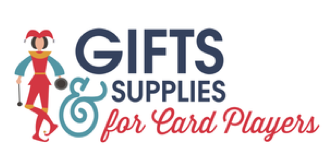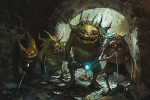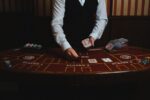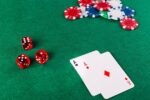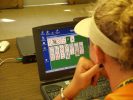Level-up your shuffling skills
Last Sunday I was hanging out at the local card shop watching people play Pokemon, the trading card game, and a young man sat down to play my daughter. He pulled out his playing deck and proceeded to deal them into nine piles. We watched for a moment then my daughter asked, “um, what are you doing?” “I’m shuffling,” he answered as though it was obvious.
While this method can shuffle a deck, it’s a bit time-consuming! I thought then it might be time to talk about the art of shuffling. Shuffling cards is not just a mundane task; it can be an art form in itself.
The Ancient Origins
Shuffling cards has a rich history that stretches back centuries. Our journey begins in ancient China, where the practice of shuffling cards originated. The history of playing cards starts in China, so it makes sense they also invented techniques like the “overhand shuffle” and the “riffle shuffle,” laying the foundation for the diverse range of shuffling methods we see today.
From Casino Floors to Magic Shows
As card games gained popularity, shuffling techniques evolved to ensure fairness and randomness. Casinos introduced techniques like the “strip shuffle” and the “riffle stack” to create an impenetrable wall of unpredictability, safeguarding against cheating. Meanwhile, magicians and card manipulators developed techniques that combined deception and dexterity, mesmerizing audiences with their sleight of hand.
Shuffling Techniques
Here are some basic shuffling techniques used by players, magicians, and professional card dealers. I’ll link each up to a youtube video that demonstrates.
The table riffle shuffle is the most common technique used by bridge players and casino dealers around the world. Start by holding the deck with both hands, thumbs on one side and fingers on the other. Press the sides of the deck with your thumbs and release, allowing the cards to cascade together on the table. The table riffle shuffle creates an audibly satisfying shuffle and ensures a thorough mix of the cards.
The overhand shuffle is one of the most basic and widely known shuffling techniques. Hold the deck in one hand and use the other hand to take small packets of cards from the top and release them onto the bottom. Repeat this process until all the cards are shuffled. The overhand shuffle is casual and relaxed, perfect for a friendly game with friends or family.
The riffle shuffle is pretty much the same as above, but in this case it’s not done on a table. Hold the deck in one hand and use your thumb to separate the cards into two equal halves. With your other hand, apply pressure on the edges of the two halves and release them, allowing the cards to cascade together, intermixing with each other. Practice is key to achieve a smooth and seamless riffle shuffle.
Originating from India, the Hindu shuffle is a method that creates a visually stunning cascade of cards. Hold the deck in one hand, and with the other hand, use your thumb to push a few cards from the top to the bottom, allowing them to interweave. Repeat this process until all the cards are shuffled. The Hindu shuffle is known for its elegant and flowing motion.
The Faro shuffle is an advanced technique that requires precision and practice. This shuffle creates a perfect alternating pattern of cards. Start by splitting the deck into two equal halves. With your thumbs, interlace the cards together, one by one, creating an interlocking pattern. The Faro shuffle is often used in professional gambling settings to achieve a perfectly randomized deck. Collectors note: I wouldn’t advise this shuffle if you’re playing with cards that you value. There’s too much opportunity for bending and damaging edges. And, use a new deck!
Improving Your Shuffling Skills
Now that we’ve explored these techniques, you’re going to want to practice! Here’s a step-by-step guide to improving your shuffling skills:
- Start with the overhand shuffle: Master the basic technique by practicing with a small number of cards, gradually increasing the deck size as your proficiency grows. Focus on maintaining a smooth flow and avoiding any clumps of cards during the shuffle.
- Move on to the riffle shuffle: Learn the mechanics of dividing the deck into two halves and riffle them together. Start with a loose grip, ensuring that the cards interleave properly. As you practice, strive for a seamless cascade and an even distribution of cards from both halves.
- Explore other techniques: Expand your repertoire by trying out the Hindu shuffle, Faro shuffle, and table riffle shuffle. Experiment with different hand placements and movements to find what feels most comfortable and natural for you.
- Practice with different deck types: Shuffling techniques may vary depending on the type of deck you’re using. Experiment with different deck sizes, card materials, and finishes to develop adaptability in your shuffling skills.
- Study and learn from experts: Watch tutorials, read books, and study the techniques used by professional card manipulators and dealers. Learning from experienced shufflers can provide valuable insights and help refine your own shuffling style. This is good advice for any skill!
- Patience and persistence: Remember, mastery comes with practice. Set aside dedicated time to refine your shuffling skills, and soon you’ll be shuffling like a pro. Don’t get discouraged by initial challenges; embrace them as opportunities to improve.
Shuffling for kids
The techniques described above are assuming adult hands. If your child is wanting to shuffle their own cards be sure to let them. For children, the actions of shuffling, cutting the deck and dealing the cards are a huge part of playing a card game. Sometimes you’ll never get past that part! Try not to grab the deck out of impatience. Here are some ways a child can shuffle the deck:
- The spread shuffle
This is bare bones shuffling but I used this method with all my kids and it does the trick – which is to shuffle a deck! It can be a bit messy, and risks damaging cards, but you’ll likely be using an old deck for kids anyhow. Let the child spread the cards, face down, all very the playing area, and then gently mess them about, moving them in broad swathes so they shuffle and mix.
- Deal out piles
Remember the guy at the Pokemon club? He was using a technique we often teach to children. It’s time consuming, but it works – and at the same time, your child will learn how to deal cards as well. Essentially you have the child deal the cards, one by one, into different piles. Nine piles is probably good but any number of piles more than, say, two. Once the deck is dealt, stack the piles on top of each other and cut the deck. Done!
If you have an eager child, we published a fun book years ago called Let’s Play Cards – it’s still available on Amazon and will be re-released soon. It has lots of fun things to do with cards, and games to learn.
Fun Facts
Mathematicians Persi Diaconis and Dave Bayer in the late 1980s and early 1990s published research revealing that seven riffle shuffles are needed to effectively randomize a standard 52-card deck. This conclusion is based on mathematical analysis and computer simulations. Their study became a landmark in the field of combinatorics and probability theory, demonstrating the application of mathematical rigor to real-world questions.
Have fun with your playing cards!
